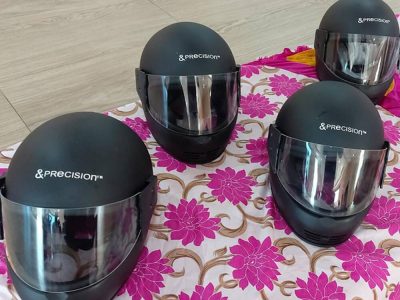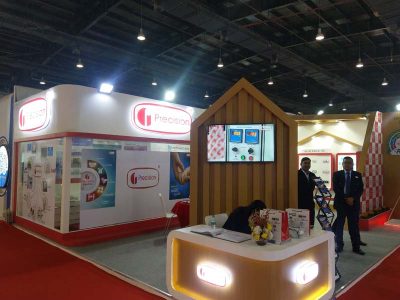
The Difference Between Modular and Non-Modular Switches
January 29, 2021
Importance Of Quality Electrical Accessories In Commercial Spaces
February 26, 2021Everything About Distribution Boards – Uses, Types & Safety Tips
Imagine it’s a typical Indian summer. The temperatures are rising. You run the air conditioner for a few hours in your bedroom, and then you take a quick shower in the connected bathroom, under hot water.
Suddenly, the electricity is cut off. Is it a power outage?
No. It’s probably a tripped miniature circuit breaker.
Given that two high-power appliances were running, presumably on the same circuit, this electromechanical device cut off the electrical supply to safeguard the circuit from overcurrent. It protected your wires from overheating and “tripped” i.e. the breaker’s switch snapped into the “Off” position.
And where is this circuit breaker located?
Along with other circuit breakers, in that concealed metal box embedded in the wall near the entrance to your apartment. If you live in a bungalow, the metal box will be in an out-of-the-way spot, under the stairs, or in the garage, storage room, or basement.
That box is where the distribution board is housed.
1. Uses of Distribution Boards
i. Electrical Distribution: It is from where you can distribute and control the electrical supply to different sections of your house. It arranges the electrical distribution into a subsidiary or miniature circuits.
ii. Electrical Security: A circuit breaker or fuse will protect each miniature circuit. Fuses are now out of use, due to their lack of reusability. These circuit breakers will be discussed below.
2. Types of Distribution Boards
Based on usage, location, and amperage, there are several types of distribution boards available today. They are used based on the electrical code in the state or district.
i. Main Breaker Panel: This type is either used for one whole commercial or residential unit. They are downstream to the supply from the meter cable. They contain the main circuit breaker that can cut off all supplies to the unit. They also indicate the amperage rating i.e. the entire electrical current the circuit can safely take.
ii. Main Lug Panel: This type is used when there is a main breaker panel upstream. They have a separate disconnector that can help disconnect it during fires and other calamities.
iii. Sub-panel: Like main lug panels, they take the supply from the main breaker panel and split it into smaller circuits for specialized appliances and sections of the house. They, however, do not have separate disconnects.
iv. Transfer Switches: This is a variant of a subpanel, which is used in series with backup power generators, to switch from the main supply. These are especially useful in stormy regions when power cuts are frequent.
See Also: Know Your MCB – Working, Trip Curves & Replacement
3. Components of Distribution Boards
The distribution board houses several electromechanical devices:
i. Main Circuit Breaker: This is the main electromechanical device that can cut off power from the meter cable.
ii. Miniature Circuit Breakers (MCB): A miniature circuit breaker controls the supply to various miniature circuits on the main circuit. They switch off if they detect an overcurrent i.e. current that supersedes the circuit’s current rating. They can be single-pole, double-pole, triple-pole, and four-pole, based on the capacity of each circuit and the required energy input of the appliances connected.
iii. Residual Current Circuit Breaker (RCCB): Put simply, RCCBs are lifesavers, mandatory in many states’ electrical codes. They can detect if the current is being leaked into a human body or into water (i.e. an earthing fault), and then automatically switch off. They are highly sensitive circuit breakers used in series with MCBs and can detect any slight imbalance between the phase conductors.
iv. Molded Case Circuit Breaker (MCCB): These devices have the same function as MCBs, except with a far higher current rating. This means it has more versatility and can interrupt larger current ranges, allowing it to be used in both residential and industrial applications.
v. Isolators: These are manually controlled electromechanical devices for isolating a part of the circuit for maintenance. They are often used in series with MCBs for when an MCB fails. Electricians use this to cut off the current in a circuit so that they can repair the circuit without getting shocked.
vi. Busbars: Busbars are copper or aluminum conducting strips that carry a large amount of current from the incoming meter line to the various circuit breakers in the distribution board.
vii. Switches: These are present on all circuit breakers and automatically switch off in case of any detection in overcurrent and short circuits.
vi. Identification Labels: These stickers help name the different miniature circuits based on the rooms they control, so that end users can understand which switch they have to flip to turn off or turn on a specific section of the house/unit.
4. Safety Tips When Using Distribution Boards
i. Covering: The distribution board must always be covered when not being manually handled. This is to prevent corrosion in the wires and fixtures from moisture, humidity, dust, etc. The unoccupied openings of distribution boards must be covered with a blanking plate.
ii. Location: Do not install the distribution board in an area where there can be contact with water. Some basements are disqualified because of this. Many electrical codes deem that they must not be placed at an inconvenient height of 2200 mm above the floor. It is preferable to install it in an out-of-the-way location where children cannot reach it and where interior aesthetics are not disturbed. Also, these boards should not be installed near a fixed cooking appliance, due to fire hazards.
iii. Warning Indication: Place a warning sign on the doors of the concealed metal box which houses the distribution board. This will prevent people from carelessly touching hazardous components.
iv. Dangerous Symptoms: If you detect a burning smell at the distribution panel, it is a serious fire hazard to your house. Turn off the power and contact a professional electrician. Also, if circuit breakers keep tripping despite you turning off appliances, this could indicate that your circuitry or board is damaged and faulty. You will need to replace it.
If you want to understand and purchase this electrician amenity for your properties and buildings, you can always contact Precision Electricals for affordable options. We have had considerable experience supplying them to the Indian B2B market for electrical components and look forward to aiding you in your venture.

































































